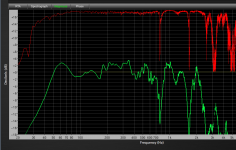I am thinking of putting in-walls, with subs in the attic. My thought was to slot load* pairs of woofers facing each other.
Then I started thinking-if the speakers are all up front, maybe I could use a higher crossover frequency. (One in-wall possibility, to avoid sound bleed and resonance evils, would be relatively small woofers in drop-in cabinets).
I know from reading long-ago AES papers that the slot can give a bit of mass loading, but also some resonances. I assume you could get some peaks or dips based on the dimensions of the slot.
Does anyone have any results about that? Does it help to taper the box, or not really? What kind of frequencies do those resonances come into play, and how severe?
*Just to be clear, by slot loading, I mean mounting a skinny, wide, and tall box on top of the ceiling, with one skinny end open through the ceiling and the woofers mounted on the big sides.
Then I started thinking-if the speakers are all up front, maybe I could use a higher crossover frequency. (One in-wall possibility, to avoid sound bleed and resonance evils, would be relatively small woofers in drop-in cabinets).
I know from reading long-ago AES papers that the slot can give a bit of mass loading, but also some resonances. I assume you could get some peaks or dips based on the dimensions of the slot.
Does anyone have any results about that? Does it help to taper the box, or not really? What kind of frequencies do those resonances come into play, and how severe?
*Just to be clear, by slot loading, I mean mounting a skinny, wide, and tall box on top of the ceiling, with one skinny end open through the ceiling and the woofers mounted on the big sides.
Tapering the slot will have little effect on the slot peak/dip, which is dependent on the dimensions and enclosed volume of the slot.
The response variation from a front loaded cone is usually a deep notch, rather than a peak. Our hearing is sensitive to peaks, not very sensitive to narrow holes in response.
The screen shot below is a down firing 10" in about a 14 x 14 x 1.5 inch plenum, the deep nulls at 775 and 1610 Hz are due to the plenum slot. Since this sub is not used above 250 Hz, the notches have no audible effect, though they would reduce harmonic distortion that happens to fall in those frequency bands.
You can use Hornresp to predict the effect the plenum will cause, model the plenum as a stubby horn.
Art
The response variation from a front loaded cone is usually a deep notch, rather than a peak. Our hearing is sensitive to peaks, not very sensitive to narrow holes in response.
The screen shot below is a down firing 10" in about a 14 x 14 x 1.5 inch plenum, the deep nulls at 775 and 1610 Hz are due to the plenum slot. Since this sub is not used above 250 Hz, the notches have no audible effect, though they would reduce harmonic distortion that happens to fall in those frequency bands.
You can use Hornresp to predict the effect the plenum will cause, model the plenum as a stubby horn.
Art
Attachments
Hi head_unit,
Somehow I managed not to post this link in Post #2: http://www.diyaudio.com/forums/subwoofers/177905-thread-those-interested-ppsl-enclosures.html
Regards,
Somehow I managed not to post this link in Post #2: http://www.diyaudio.com/forums/subwoofers/177905-thread-those-interested-ppsl-enclosures.html
Regards,
Hornresp, eh? I've never used it, but I'll have to give that a shot.
Thanks sooo much for the response post. 14x14 probably exacerbates the nulls. I wonder what happens if it becomes like 10x14. OR if you do it PPSL style (great thread!) where one magnet is in the slot, breaking up the regularity of it.
If I played my cards right, I could have one side of the slot go flush to the wall.
Thanks sooo much for the response post. 14x14 probably exacerbates the nulls. I wonder what happens if it becomes like 10x14. OR if you do it PPSL style (great thread!) where one magnet is in the slot, breaking up the regularity of it.
If I played my cards right, I could have one side of the slot go flush to the wall.
- Status
- Not open for further replies.
